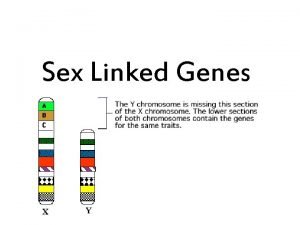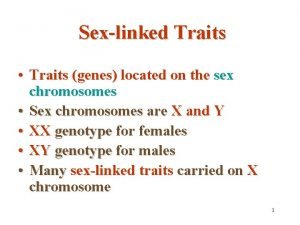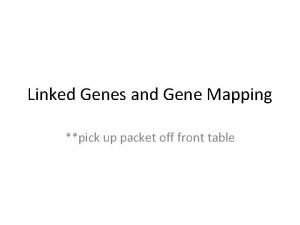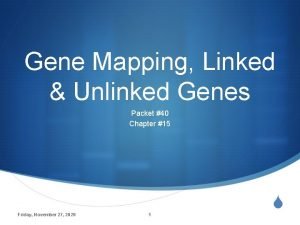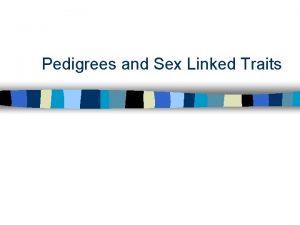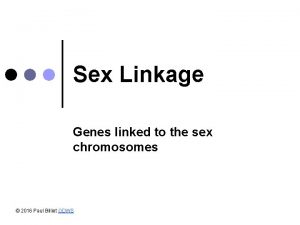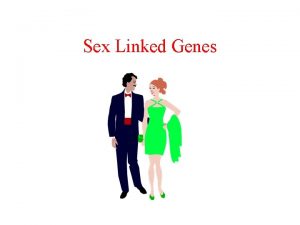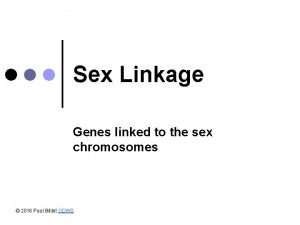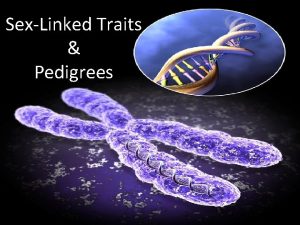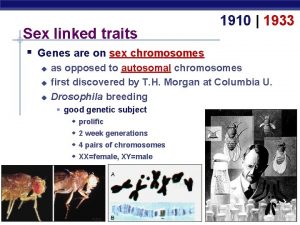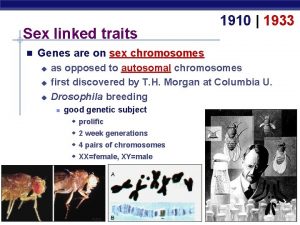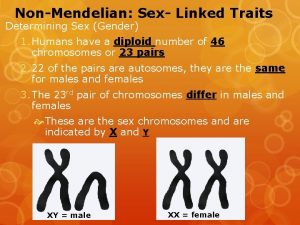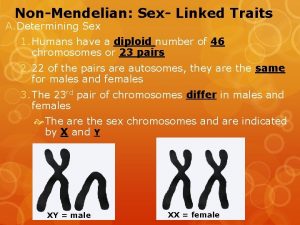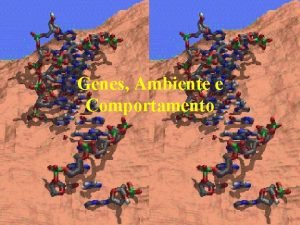Sex linked Traits Genes for these traits are
















- Slides: 16

Sex – linked Traits • Genes for these traits are located only on the X chromosome (NOT on the Y chromosome) • X linked alleles always show up in males whether dominant or recessive because males have only one X chromosome

• Examples of recessive sex-linked disorders: 1. colorblindness – inability to distinguish between certain colors You should see 58 (upper left), 18 (upper right), E (lower left) and 17 (lower right). Color blindness is the inability to distinguish the differences between certain colors. The most common type is red-green color blindness, where red and green are seen as the same color.

2. hemophilia – blood won’t clot

• Example: A female that has normal vision but is a carrier for colorblindness marries a male with normal vision. Give the expected phenotypes of their children. N = normal vision n = colorblindness XN Xn X XN Y XN Xn X NX N X NX n X NY X n. Y Y Phenotype: 2 normal vision females 1 normal vision male 1 colorblind male

Mutations • Mutation – sudden genetic change (change in base pair sequence of DNA) • Can be : Harmful mutations – organism less able to survive: genetic disorders, cancer, death Beneficial mutations – allows organism to better survive: provides genetic variation Neutral mutations – neither harmful nor helpful to organism • Mutations can occur in 2 ways: chromosomal mutation or gene/point mutation

Chromosomal mutation: • less common than a gene mutation • more drastic – affects entire chromosome, so affects many genes rather than just one • caused by failure of the homologous chromosomes to separate normally during meiosis • chromosome pairs no longer look the same – too few or too many genes, different shape


• Examples: Down’s syndrome – (Trisomy 21) 47 chromosomes, extra chromosome at pair #21

Turner’s syndrome – only 45 chromosomes, missing a sex chromosome (X) Girls affected – short, slow growth, heart problems

Klinefelter’s syndrome – 47 chromosomes, extra X chromosomes (XXY) Boys affected – low testosterone levels, underdeveloped muscles, sparse facial hair

• Having an extra set of chromosomes is fatal in animals, but in plants it makes them larger and hardier. Hardier

Gene or Point Mutation • most common and least drastic • only one gene is altered

• Examples: Recessive gene mutations: Sickle cell anemia – red blood cells are sickle shaped instead of round and cannot carry enough oxygen to the body tissues – heterozygous condition protects people from malaria

Cystic fibrosis – mucous builds up in the lungs Tay-Sachs Disease – deterioration of the nervous system – early death Mutated genes produce enzymes that are less effective than normal at breaking down fatty cell products known as gangliosides. As a result, gangliosides build up in the lysosomes and overload cells. Their buildup ultimately causes damage to nerve cells.

Phenylketonuria (PKU) – an amino acid common in milk cannot be broken down and as it builds up it causes mental retardation – newborns are tested for this Dominant gene mutations: Huntington’s disease – gradual deterioration of brain tissue, shows up in middle age and is fatal Dwarfism – variety of skeletal abnormalities

Detecting Genetic Disorders • picture of an individual’s chromosomes – karyotype • amniotic fluid surrounding the embryo is removed for analysis – amniocentesis Female with Down’s syndrome
 Linked genes and unlinked genes
Linked genes and unlinked genes Linked genes and unlinked genes
Linked genes and unlinked genes What are sex linked genes
What are sex linked genes Antigentest åre
Antigentest åre Greenhouse sex
Greenhouse sex Xxtesticles
Xxtesticles Sex sex sex
Sex sex sex Sex sex sex
Sex sex sex Sex sex sex
Sex sex sex Sex influenced traits
Sex influenced traits X linked punnett square
X linked punnett square What are sexlinked traits
What are sexlinked traits Y chromosome traits
Y chromosome traits Punnett square for blood type
Punnett square for blood type Glomerulus
Glomerulus Linked genes
Linked genes Linked vs unlinked genes
Linked vs unlinked genes


